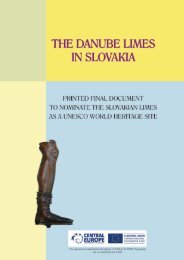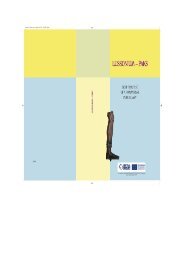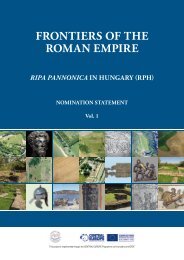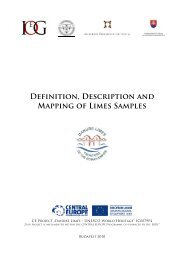opinion forming actions in austria and germany - Danube Limes
opinion forming actions in austria and germany - Danube Limes
opinion forming actions in austria and germany - Danube Limes
Create successful ePaper yourself
Turn your PDF publications into a flip-book with our unique Google optimized e-Paper software.
Core Output 3.4.3.: OPINION FORMING ACTIONS IN AUSTRIA AND GERMANY<br />
__________________________________________________________________<br />
P. Henrich also attended a Intergovernmental Committee meet<strong>in</strong>g <strong>in</strong> Wiesbaden to discuss<br />
the Management-Plans of the WHS “Frontiers of the Roman Empire” <strong>and</strong> a Bratislava-Group<br />
Meet<strong>in</strong>g <strong>in</strong> the Saalburg concern<strong>in</strong>g the Management-Plan <strong>and</strong> the Central Europe Project.<br />
P. Henrich participated <strong>in</strong> the <strong>Limes</strong>congress <strong>in</strong> Newcastle to coord<strong>in</strong>ate scientific research<br />
on the <strong>Limes</strong> on an <strong>in</strong>ternational level. The f<strong>in</strong>al phase of the project activities <strong>in</strong> Germany<br />
saw contacts with the adm<strong>in</strong>istration of the L<strong>and</strong>esdenkmalamt <strong>in</strong> Wiesbaden to organize the<br />
new Management Plan <strong>and</strong> the <strong>in</strong>volvement of various stakeholders. The data collection<br />
shows what happened to the <strong>Limes</strong> s<strong>in</strong>ce the nom<strong>in</strong>ation. Afterwards the text of the<br />
Management Plan could be revised accord<strong>in</strong>g the results of the data collection. It will be<br />
f<strong>in</strong>ally discussed with the jurists <strong>in</strong> the German <strong>Limes</strong>commission.<br />
The pr<strong>in</strong>ted document will be h<strong>and</strong>ed out to all the stakeholders def<strong>in</strong>ed under B.3.<br />
2. Archaeological Cadastre Straub<strong>in</strong>g<br />
Whereas the dist<strong>in</strong>ction between “exist<strong>in</strong>g” <strong>and</strong> “destroyed” <strong>in</strong> ancient monuments is fairly<br />
easy <strong>in</strong> the open countryside this causes major problems <strong>in</strong> urban surround<strong>in</strong>gs. In towns,<br />
villages <strong>and</strong> <strong>in</strong>dustrial settlements the collection of <strong>in</strong>formation on archaeological monuments<br />
is much more difficult as most methods of prospect<strong>in</strong>g fail due to small parcels, covered<br />
surfaces, disturbances <strong>and</strong> pollution.<br />
Independent of the visual appearance, however, it is not uncommon that between <strong>and</strong> under<br />
<strong>in</strong>tensive constructions ancient monuments are very well preserved. Often conditions here<br />
are even better than <strong>in</strong> the open countryside due to their protection by later layers of debris<br />
<strong>and</strong> rema<strong>in</strong>s of demolition, sometimes ancient monuments <strong>in</strong> themselves. However, the<br />
<strong>in</strong>tensive use of these areas for cellars, cess-pits, wells, <strong>and</strong> l<strong>in</strong>es of <strong>in</strong>frastructure often led<br />
to a punctuation of the evidence by small scale destruction. Accord<strong>in</strong>gly, conditions of<br />
ancient monuments under these circumstances <strong>and</strong> changes of preservation occur on a very<br />
small scale <strong>and</strong> may vary meter by meter.<br />
Hadrian’s Wall <strong>and</strong> the Upper German-Raetian <strong>Limes</strong> with<strong>in</strong> the World Heritage Site<br />
‘Frontiers of the Roman Empire’ (FRE WHS) <strong>in</strong>clude a number of forts <strong>and</strong> their military vici<br />
underneath medieval <strong>and</strong> modern settlements. In many of the proposed future elements of<br />
the WHS along the rivers Rh<strong>in</strong>e <strong>and</strong> <strong>Danube</strong> even the majority of sites were used<br />
cont<strong>in</strong>uously s<strong>in</strong>ce the Roman times. As UNESCO accepted for the Upper German-Raetian<br />
<strong>Limes</strong> the dist<strong>in</strong>ction of underground levels with WH-qualification overlaid by medieval <strong>and</strong><br />
modern construction without WH-status the extent <strong>and</strong> quality of areas underground have to<br />
be specified, described <strong>and</strong> mapped.<br />
Cadastres – that is, the mapp<strong>in</strong>g of different layers of a town’s history <strong>and</strong> development – are<br />
<strong>in</strong>struments for documentation as well as for management. Archaeological cadastres <strong>in</strong><br />
particular offer knowledge on comparable levels <strong>and</strong> guidance towards the deal<strong>in</strong>g with<br />
archaeological heritage <strong>in</strong> difficult terra<strong>in</strong>, <strong>in</strong> particular built-up areas, on the basis of a sound<br />
evaluation (or the pr<strong>in</strong>ciples www.l<strong>and</strong>esdenkmalamt-bw.de/publikation/stadtkataster.php).<br />
In particular, the follow<strong>in</strong>g elements are important for an archaeological cadastre:<br />
1. Mapp<strong>in</strong>g of archaeological evidence. This leads to a detailed knowledge of the<br />
whereabouts, depth <strong>and</strong> quality of exist<strong>in</strong>g parts of the archaeological heritage<br />
(positive results). To be precise, knowledge of excavated <strong>and</strong> destroyed parts is<br />
transferred to parts not destroyed <strong>in</strong> the direct vic<strong>in</strong>ity;<br />
2. Mapp<strong>in</strong>g of all disturbances of the archaeological heritage. Cellars, underground<br />
garages, <strong>in</strong>frastructure, but also excavations <strong>and</strong> medieval as well as pre-modern<br />
constructions <strong>in</strong> depth (which sometimes <strong>in</strong> themselves may be protected<br />
26











